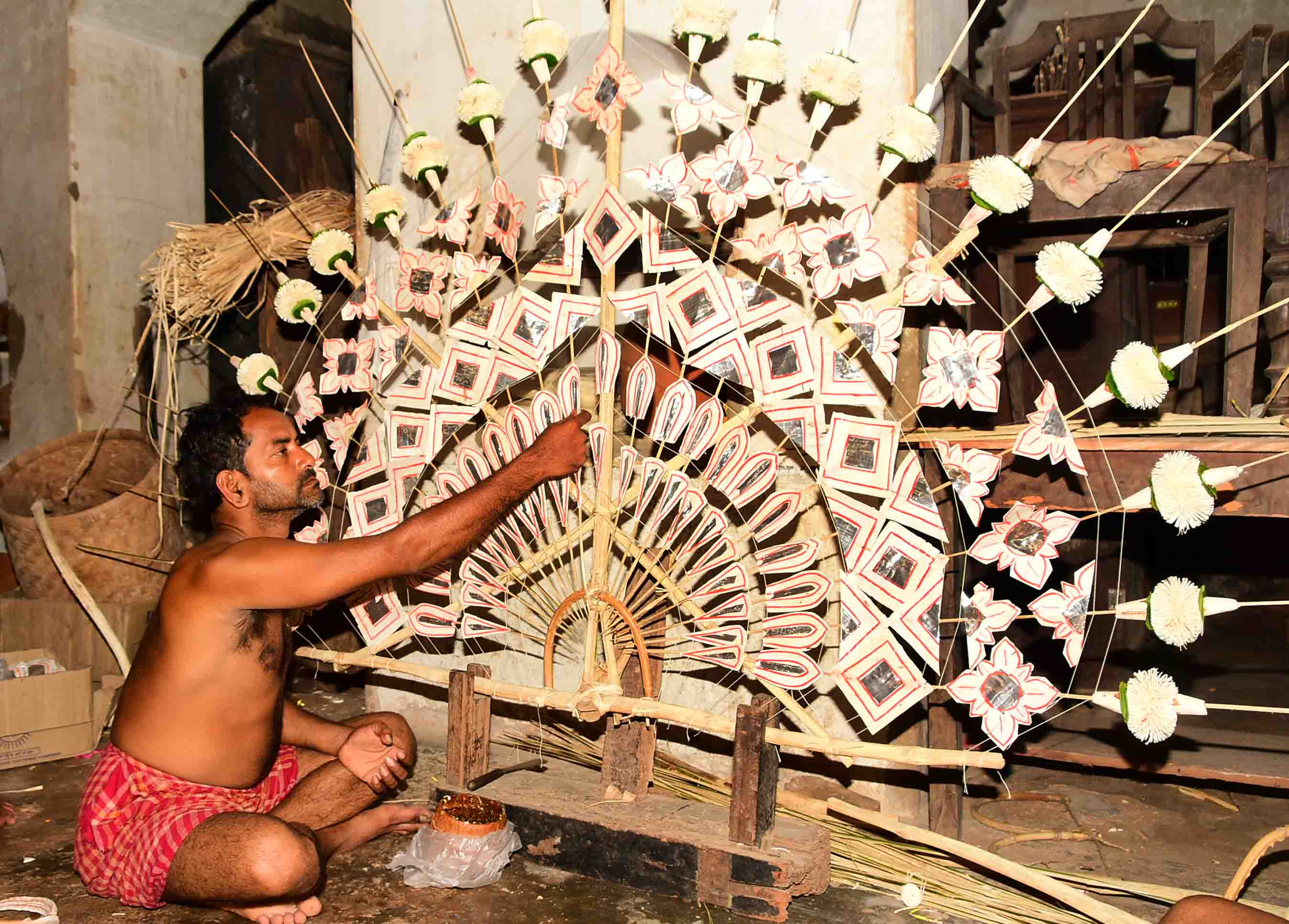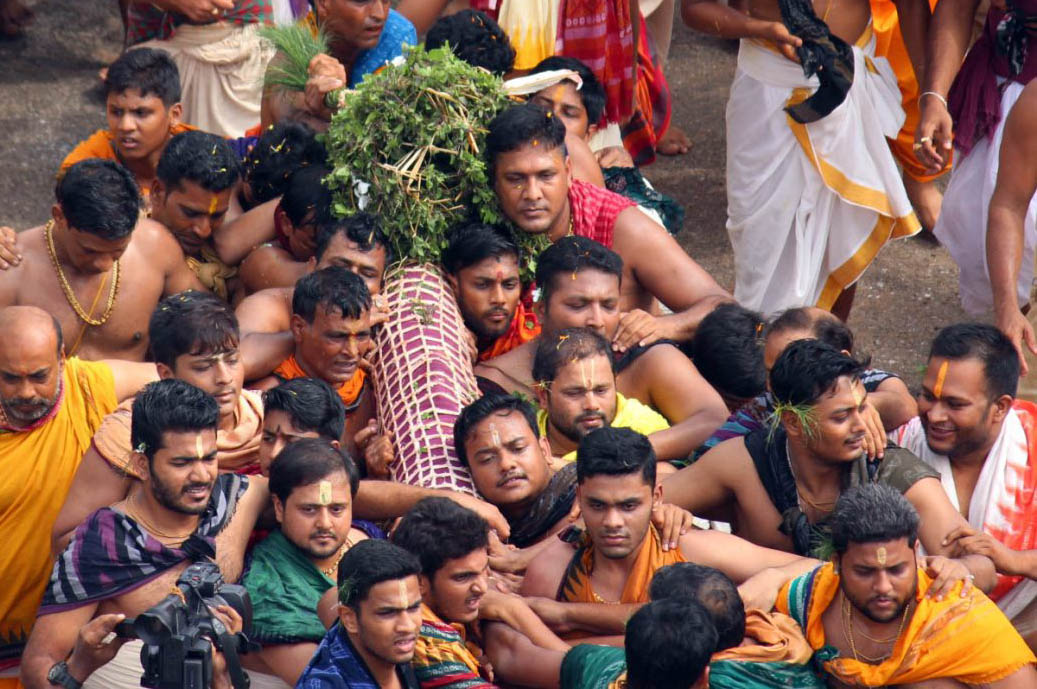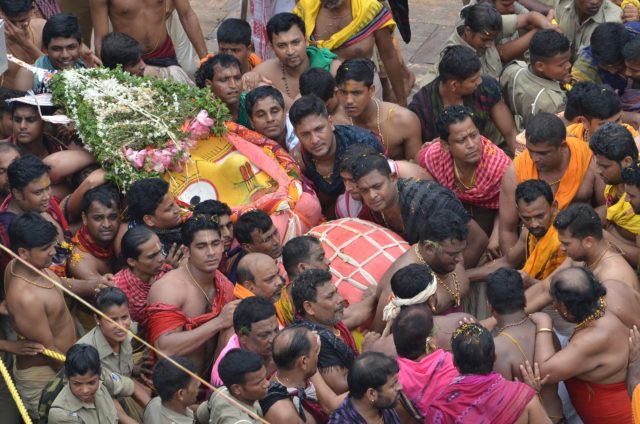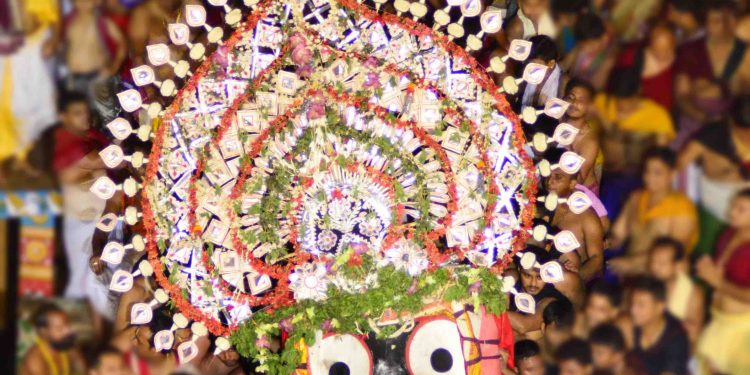Come July 4 and Puri will once again become the centre of attraction for millions of devotees of Lord Jagannath, Lord Balabhadra and Devi Subhadra. Interestingly, Lord Jagannath is the only God who comes out of the temple to give his devotees darshan, irrespective of the caste or creed they belong to.
On the day of the Rath Yatra, Puri becomes chock-a-block with devotees congregating in front of the temple to witness the annual outing of the Trinity. The teeming crowds go wild with ecstasy as the deities step out of the Singhadwara fitted with large, elaborate floral tiaras called tahia, which are fixed to a heart-shaped bamboo frame and are carried forward in slow, swaying movements amidst the beat of cymbals, gongs and the sound of conches. Similar but smaller floral decorations are attached to the idols of Goddess Subhadra and Sudarshana.
A lot of effort goes into the making of these intricately designed and decorated tahias. The tahias are brought to the temple early in the morning on the day of the Rath Yatra and placed on the heads of the idols before the journey from the temple to the chariots begins. The tahias are made at Raghav Das Mutt, located in front of the southern gate of the Srimandir. Although there’s no historical evidence about the period from when tahias are being made at this place, devotees say that it has been ages.

Basant Kumar Rana, the chief craftsman along with a team of craftsmen, has been designing and making the tahias at Raghav Das Mutt since 1996. He says, “I prepare the tahias for both Rath Yatra and Bahuda Yatra. However, the size of the tahias for the two occasions is different. On Rath Yatra, bigger tahias are used compared to Bahuda Yatra. The door of Srimandir is bigger than the door of Gundicha, so a smaller tahia is preferred for Bahuda Yatra.”
For Basant, making tahias is more a way of expressing his devotion towards the Lord than just an assignment. “I am an insignificant being but a part of me unites with the Lord when he puts on the tahia that every devotee identifies with when the Lord comes out during pahandi,” he says, adding, “Making the tahias is more an emotional involvement for me and not easy to explain. I am completely dedicated towards my duty while making the tahias and piousness and spiritual calmness descends on my mind. There’s a feeling that I am not doing anything, instead the Lord is getting all the work done through me.”
Tahia-making follows an intricate process and Basant is assisted by a team of workers from Raghav Das Mutt. Basant learnt the art of making tahias at a very young age. However, he is yet to pass on the expertise to the next generation. “I am a bachelor, so I will pass on the knowledge to child sevayats of some servitor family,” says Basant.

The tahias are considered a gift from the goddess to Lord Jagannath as he embarks on his annual sojourn. Unlike other gods or deities, tahia is the only jewellery that the sibling deities don during various rituals. Tahias are worn during Snana Purnima, Rath Yatra, Bahuda Yatra and Niladri Bije. Meticulously created with complete dedication and spiritual fervour, the tahias are never repeated and every time a new tahia is used. During the procession, devotees jostle for these magnificent swaying floral crowns and take the pieces home as souvenirs of the Trinity, while the craftsman quietly but smilingly watches his months-long efforts disappear into fragments.
“The pleasure of witnessing the devotion of millions for Lord Jagannath is a lot more than the pain of seeing the tahia disappear within minutes. I’m no different from the other devotees. It is all for brotherhood and devotion. I also love to see the downpouring of affection when servitors snatch away bits of tahia to keep a souvenir of our deity,” Basant adds.
Craftsmen work for two months to put together all the elements of the tahia. They follow a strict regimen during the tahia-making period. The preparations for crafting the tahias start on Akshaya Tritiya, coinciding with the beginning of the construction of the chariots. From this day till the tahias are done, craftsmen can eat only vegetarian food. Moreover, the artisans have to wash their feet every time they return to the sacred place where tahias are assembled.

The framework of the elaborate tahias are first prepared using bamboo, cane, banana stem, thermocol, zari and other colourful elements. It is then adorned with flowers like rangini, duba, tulsi and other fragrant flowers a day before the Rath Yatra. Prior to that, the chitrakara sevayats or painters of the temple touch up the tahias with organic colours.
“A total of 24 floral tahias are put together for Jagannath, Balabhadra, Subhadra and Sudarshan. It takes roughly 15 days to make each tahia,” informs Basant.
Bamboo sticks are used to structure the base of the tahias into the shape of a betel leaf. The bamboo sticks are then covered with banana stems to give them a smooth finish. Interestingly, all measurements are done with fingers and not with scales.
The frames are also decorated with fresh flowers like rangani, malti, jui, mali, champa and lotus. Duba grass and tulsi are stringed atop the crowns. Pieces of thermocol cut out in the shape of burflowers, arrows and squares are then placed on the tahias.
Each part of the tahia is made using natural substances. Apart from flowers, glitter and colourful lace are also used to enhance the beauty of the tahias with the help of a gum made from wood apple. Besides, stone colours are used, hence keeping the old practices alive.
According to a servitor of the temple, the tahias are decorative pieces that enhance the beauty of the sibling deities.
Legend of the tahia
The crowning of the gods during the Pahandi ritual is an age-old custom. According to one legend, a devotee named Raghu Arakhita Das was meditating under the scorching sun near the temple’s Singhadwara. The then king used to arrange for shade for the devotees through a Tati (cover made with bamboo) to save them from the heat and he built the same for Raghu Arakhita. However, the saint broke the tati as he found no use for it. Lord Jagannath, in the guise of a milkman, raised a traditional umbrella over Raghu Arakhita to save him from the sun’s rays while the latter was meditating in the open. Das in return urged the Lord to allow him to provide tahias for the three deities during the car festival. Raghu exclaimed, “Oh Lord, you gave me tati but I can’t give anything to you, so I will give you a tahia when you come out of your temple.” The story goes that he started the custom and the then king approved it. Since then, Raghav Das Mutt where Raghu Arakhita was staying has been providing tahias for the deities.
About the Tahia
- Bamboo sticks are tied together with cotton strings to give the tahia its shape. Cane is also used at specific places.
- The tahias which are used on the day of Rath Yatra and Niladri Bije are bigger in size and are known as Mayura Chandrika.
- While Lord Jagannath’s tahias for the Rath Yatra and Niladri Bije are more than seven feet in height, Lord Balabhadra’s is around five-and-a-half feet.
- Devi Subhadra’s tahia is known as Pania and is three feet in height, while Lord Sudarshan’s tahia is known as Chula o Chandrika and is two feet in height.
- Three-feet high tahias are used while entering and leaving the Gundicha Temple since it has a small doorway.
- When the idols of the trinity are taken to the chariots, they wear no precious jewellery, except the tahia.
- Raghav Das Mutt authorities provide 24 tahias for the deities. Customarily, Srimandir servitors require eight big tahias and 16 small ones to decorate the deities for Rath Yatra.
- Eight tahias are required for decorating the Trinity and Lord Sudarshan during the Snana Purnima ritual.
- Four tahias are placed on the deities during Pahandi procession at Srimandir on the occasion of Rath Yatra.
- The deities are also decorated with four tahias when they are carried from the chariots to Sri Gundicha temple.
- Another four tahias are used for the Pahandi procession during Bahuda Yatra.
- Four tahias are required for the Niladribije ritual at the culmination of Rath Yatra
SOYONG, OP






































